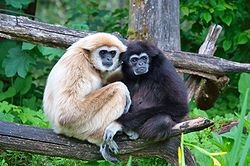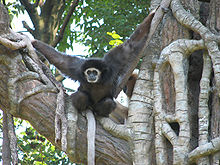- Lar gibbon
-
Lar gibbon[1] 
Pair Conservation status Scientific classification Kingdom: Animalia Phylum: Chordata Class: Mammalia Order: Primates Family: Hylobatidae Genus: Hylobates Species: H. lar Binomial name Hylobates lar
(Linnaeus, 1771)
Lar Gibbon range The lar gibbon (Hylobates lar), also known as the white-handed gibbon, is a primate in the Hylobatidae or gibbon family. It is one of the better-known gibbons and is often seen in zoos.
Contents
Range
The range of the lar gibbon historically extended from southwest China to Thailand and Burma down the whole Malay Peninsula in primary and secondary tropical rain forests. It is also present in the northwest portion of the island of Sumatra. In recent decades, especially the continental range has been reduced and fragmented, and the animals are thought to be extirpated in China.[3] The gibbon genus is highly allopatric, usually separated by large rivers. The lar gibbon shares its range with only the siamang, Symphalanges syndactylus, on the tip of the Malaysian peninsula and Sumatra.
Appearance
The fur coloring of the lar gibbon varies from black and dark-brown to light brown sandy colors. The hands and feet are white colored, likewise a ring of white hair surrounds the black face. Both males and females can be all color variants, and the sexes also hardly differ in size. Gibbons are true brachiators, propelling themselves through the forest by swinging under the branches by their arms. Reflecting this mode of locomotion, the white-handed gibbon has curved fingers, elongated hands, extremely long arms and relatively short legs, giving it an intermembral index of 129.7, one of the highest of the primates.[4] As with all apes, the number of caudal vertebrae has been reduced drastically, resulting in the loss of a functional tail. Gibbons have tough bony padding on their buttocks, known as the ischial callosities, or sitting pads.
Diet and dentition
The lar gibbon is considered frugivorous with fruit constituting 50% of its diet, but leaves (29%) are a substantial part, with insects (13%) and flowers (9%) forming the remainder [4]. Its dental formula is 2.1.2.3/2.1.2.3, the generalized formula for Old World monkeys and apes. The dental arcade is U-shaped, and the mandible is thin and light. The incisors are broad and flat, while the molars have low, rounded cusps with thick enamel. The most noticeable characteristic of the dentition of Hylobates lar is the presence of large, dagger-like canines in both the upper and lower jaw. These canines are not sexually dimorphic.
Behavior
Lar gibbons are diurnal and arboreal, inhabiting rain forests. They rarely come to the ground, instead using their long arms to brachiate through the trees. With their hooked hands they can move swiftly with great momentum, swinging from the branches. Although they rarely come to the ground naturally, when on the ground they walk bipedally with arms raised above the heads for balance,.Its social organization is dominated by monogamous family pairs, with one breeding male and one female along with their offspring. When a juvenile reaches sexual maturity, it is expelled from the family unit. However, this traditional conception has come under scrutiny. Long-term studies conducted in Khao Yai National Park in Thailand suggest that their mating system is somewhat flexible, incorporating extra-pair copulations, partner changes and polyandrous groupings.[5]
Pair of Lar Gibbons hooting in Copenhagen Zoo
Family groups inhabit a firm territory, which they protect by warding off other gibbons with their calls. Each morning the family gathers on the edge of its territory and begins a "great call," a duet between the breeding pair. Each species has a typified call and each breeding pair has unique variations on that theme. The great call of Hylobates lar is characterized by its frequent use of short hoots with more complex hoots, along with a "quavering" opening and closing.[6] These calls are one of the traits used determining species differences among the gibbons.[7]
Reproduction
Sexually they are similar to other gibbons. Gestation is seven months long and pregnancies are usually of a single young. Young are nursed for approximately two years, and full maturity comes at about 8 years. The life expectancy of the lar gibbons in the wild is about 25 years.
Status
Lar gibbons are threatened in various ways: they are sometimes hunted for their meat, sometimes a parent is killed in order to capture young animals for pets and the largest danger is the loss of habitat.
Subspecies
There are five subspecies of Lar Gibbon:[1][7]
- Malaysian lar gibbon, Hylobates lar lar
- Carpenter's lar gibbon, Hylobates lar carpenteri
- Central lar gibbon, Hylobates lar entelloides
- Sumatran lar gibbon, Hylobates lar vestitus
- Yunnan lar gibbon, Hylobates lar yunnanensis (possibly extinct)
References
- ^ a b Groves, C. (2005). Wilson, D. E., & Reeder, D. M, eds. ed. Mammal Species of the World (3rd ed.). Baltimore: Johns Hopkins University Press. pp. 179-180. OCLC 62265494. ISBN 0-801-88221-4. http://www.bucknell.edu/msw3/browse.asp?id=12100761.
- ^ Brockelman, W. & Geissmann, T. (2008). Hylobates lar. In: IUCN 2008. IUCN Red List of Threatened Species. Downloaded on 4 January 2009.
- ^ "Weisshandgibbons in China ausgestorben" (Press release). University of Zurich. 15.05.2008. http://www.mediadesk.unizh.ch/mitteilung.php?text_id=294&grp=aktuell. Retrieved 2008-05-19.
- ^ a b Rowe, Noel. Pictorial Guide to the Living Primates. East Hampton, N.Y. : Pogonias Press, 1996.
- ^ Sommer, V. & Reichard, U. (2000). "Rethinking Monogamy: The Gibbon Case". In P. Kappeler, ed.. Primate Males. Cambridge: Cambridge University Press. pp. 159–168.
- ^ Geissmann, Thomas. "Sound Gallery: Hylobates lar". http://gibbons.de/main/sound/03lar.html. Retrieved 2009-04-29.
- ^ a b Geissmann, Thomas. "Gibbon Systematics and Species Identification". http://gibbons.de/main/system/intro.html. Retrieved 2009-04-29.
External links
- ARKive - images and movies of the white-handed gibbon (Hylobates lar)
- Lar Gibbon photos
- Lar Gibbon songs
- Gibbon Conservation Center
- Lar Gibbon at Animal Diversity Web
- Thomas Geissmann's Gibbon Research Lab and Gibbon Network
Extant species of family Hylobatidae (Gibbons) Hylobates Hoolock Symphalangus Nomascus CategoryCategories:- IUCN Red List endangered species
- Mammals of Burma
- Mammals of Laos
- Mammals of Thailand
- Gibbons
- Animals described in 1771
- Mammals of Indonesia
- Mammals of Malaysia
- Mammals of China
- Fauna of Sumatra
Wikimedia Foundation. 2010.


